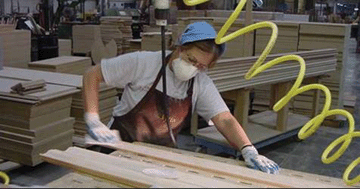Abstract
Symptoms such as shortness of breath and cough have been noted in woodworking facilities even where wood dust itself is well-controlled. Suspicion has fallen on other possible contaminants in the workplace atmosphere, including bacterial endotoxin. A few studies have indicated potentially high endotoxin exposure with exposure to fresh wood in sawmills and in the production of fiberboard and chipboard, but fewer studies have been carried out on exposure to endotoxin in dry wood work, for example in joineries. A study of the endotoxin content of airborne wood dust samples from US woodworking facilities is presented, from the re-analysis of samples which previously had been taken to establish mass collection relationships between the IOM sampler, the closed-face 37 mm plastic cassette (CFC) sampler and the Button sampler. Endotoxin was strongly correlated with total dust, but the endotoxin content of a few fresh wood samples was found to be up to ten times higher per unit of wood dust than for dried-wood samples, and this difference was significant. No long-term time-weighted average sample exceeded the recommended limit value of 50 EU m−3 (EU, endotoxin units)used in the Netherlands, although a number of the IOM samples came close (seven samples or 44% exceeded 20 EU m−3) and one short-term (48 minute) sample registered a high value of 73 EU m−3. The geometric mean concentration from the IOM samples (11 EU m−3) is within the range of geometric means found from Australian joineries (3.7–60, combined: 24 EU m−3). In contrast, the corresponding values from the CFC (3.6 EU m−3), and the Button sampler (2.1 EU m−3) were much lower and no samples exceeded 20 EU m−3. Endotoxin is likely only to be a significant problem in working with dried woods when associated with very high dust levels, where the wood dust itself is likely to be a cause for concern. The results from the few samples in this study where fresh wood was being worked were similar to results from other studies involving fresh woods. The agreement between these studies is encouraging given the difficulties of endotoxin analysis and the wide variation often expected between different laboratories.


 Please wait while we load your content...
Please wait while we load your content...